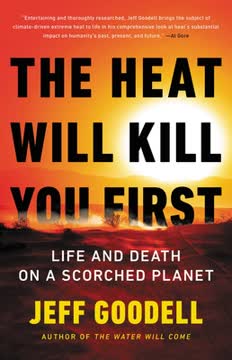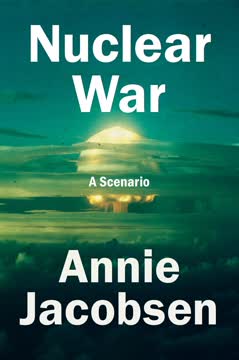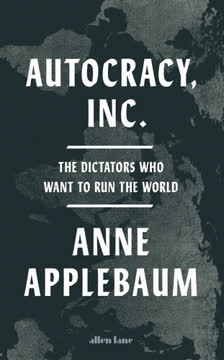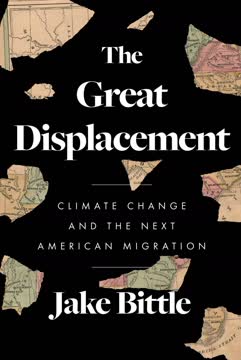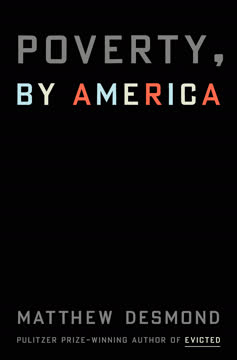Key Takeaways
1. Heat is an Invisible, Active Force Shaping Our World
The kind of heat I’m talking about here is not an incremental bump on the thermometer or the slow slide of spring into summer. It is heat as an active force, one that can bend railroad tracks and kill you before you even understand that your life is at risk.
Heat's underestimated power. Heat is often perceived as a gradual change in temperature, but it's a potent, often invisible force with the capacity to cause widespread destruction and death. It's not merely an inconvenience; it's a fundamental driver of planetary chaos, capable of melting ice sheets, igniting wildfires, and disrupting ecosystems.
The Gerrish family tragedy. The tragic deaths of the Gerrish family in the Sierra Nevada foothills serve as a stark reminder of heat's potential lethality. Their story underscores the importance of understanding the risks of hiking in extreme heat, even on seemingly familiar trails. The family's lack of awareness, combined with the unforgiving conditions, led to a devastating outcome.
Beyond incrementalism. The book challenges the conventional understanding of heat as a linear, controllable phenomenon. Instead, it presents heat as an active agent, capable of causing sudden and catastrophic changes. This shift in perspective is crucial for recognizing and responding to the growing threat of extreme heat in a rapidly warming world.
2. Humans Evolved Clever Heat Management Systems
By managing heat, humans were able to go farther from water holes, begin long-distance travel, and expand their hunting range.
Evolutionary adaptations. Humans, like all living things, have evolved sophisticated mechanisms for managing heat. From bipedalism to eccrine sweat glands, these adaptations allowed our ancestors to thrive in diverse environments. However, these systems are optimized for a specific range of temperatures and are increasingly challenged by the rapid pace of climate change.
The importance of sweating. The development of eccrine sweat glands, which are unique to humans, was a pivotal moment in our evolutionary history. This efficient cooling system allowed our ancestors to hunt and travel long distances in hot climates, giving them a significant advantage over other species.
Limits to adaptation. While humans are remarkably adaptable, there are limits to our ability to cope with extreme heat. As temperatures rise, our bodies struggle to maintain a stable internal temperature, leading to heat exhaustion, heatstroke, and ultimately, death. Understanding these limits is crucial for protecting ourselves and others in a warming world.
3. Urban Heat Islands Expose Deep Inequities
In a heat wave, wealth can afford twenty-five degrees of coolness.
The urban heat island effect. Cities, with their abundance of concrete, asphalt, and steel, trap and amplify heat, creating urban heat islands that can be significantly hotter than surrounding areas. This phenomenon disproportionately affects low-income neighborhoods with less green space and fewer resources to combat the heat.
Temperature apartheid. The book highlights the stark inequalities in access to cooling resources, with wealthier residents able to afford air-conditioning and other heat-mitigation measures while poorer residents are left to swelter in uninsulated homes. This "temperature apartheid" exacerbates existing social and economic disparities.
Chennai and Phoenix. The stories of Anjalai in Chennai and Leonor Juarez in Phoenix illustrate the daily struggles of people living in extreme heat with limited resources. These personal narratives underscore the urgent need for equitable solutions to address the growing threat of urban heat.
4. Extreme Heat Drives Migration of All Living Things
As the temperature rises, it will drive a great migration—of humans, of animals, of plants, of jobs, of wealth, of diseases.
A world on the move. As temperatures rise, living things are forced to migrate in search of more hospitable climates. This mass movement includes humans, animals, plants, and even diseases, creating new challenges and uncertainties for ecosystems and societies.
The lure of cheaper land. Despite the risks, many people are moving to areas with high climate risks, drawn by lower housing costs and access to nature. This trend highlights the complex factors that influence migration decisions and the need for better information and planning to ensure safe and sustainable communities.
The story of Melanie Elliott and Andrew McGowan. The story of Melanie Elliott and Andrew McGowan, fleeing Hurricane Harvey, illustrates the human side of climate migration. Their journey to San Diego, driven by the need to escape the constant flooding in their hometown, underscores the growing displacement caused by extreme weather events.
5. Heat Weaponization and the Weaponization of Ignorance
Part of their strategy is to funnel migrants through the hottest, most dangerous regions of the border.
Heat as a tool of control. The book explores the disturbing ways in which heat can be weaponized, both intentionally and unintentionally. The US Border Patrol's strategy of funneling migrants through the most dangerous regions of the desert is a chilling example of how heat can be used to deter and harm vulnerable populations.
The Gerrish family tragedy. The tragedy of the Gerrish family is not just a consequence of bad luck and poor decision-making in the wild. It was a tragedy that was shaped by our larger failure to reckon with the risks of life in a rapidly warming world, and with the nature of heat itself.
The weaponization of ignorance. The book also examines how ignorance and denial can be weaponized, allowing those in power to ignore the suffering of others and perpetuate systems that exacerbate climate change. This form of weaponization is particularly insidious, as it allows harm to be inflicted without direct intent.
6. Attribution Science Connects Extreme Events to Climate Change
To me, science is—or can be—a tool for justice. Extreme event attribution is the first science ever developed with the court in mind.
Linking events to climate change. Extreme event attribution is a revolutionary new field of climate science that allows scientists to determine the extent to which specific extreme weather events are caused by human-induced climate change. This science has the potential to hold polluters accountable for the damages caused by their actions.
Friederike Otto's work. The work of Friederike Otto, a leading figure in attribution science, is highlighted. Her research has demonstrated that many extreme heat waves would have been "virtually impossible" without climate change, providing a powerful tool for understanding and communicating the impacts of our actions.
Implications for legal liability. The ability to attribute extreme weather events to climate change opens the door to legal remedies, allowing individuals and communities to sue greenhouse gas emitters for the damages they have caused. This could have profound implications for the fossil fuel industry and the future of climate policy.
7. The Ocean's Role in Absorbing and Redistributing Heat
Without the ocean, the atmosphere would be a lot hotter than it already is.
The ocean as a heat sink. The ocean has absorbed about 90 percent of the additional heat trapped by greenhouse gases, acting as a crucial buffer against the worst effects of climate change. However, this absorption comes at a cost, leading to rising ocean temperatures, acidification, and other harmful changes.
Marine heat waves. The book explores the phenomenon of marine heat waves, which are becoming more frequent and intense due to climate change. These events can devastate marine ecosystems, causing mass die-offs of coral reefs, kelp forests, and other vital habitats.
Impacts on weather patterns. The ocean plays a critical role in regulating global weather patterns, and changes in ocean temperature can have far-reaching consequences. A warming ocean can intensify storms, alter rainfall patterns, and disrupt ocean currents, leading to unpredictable and potentially catastrophic weather events.
8. The Fragility of Food Systems in a Warming World
The largest single global change that threatens food security is high temperature.
Heat's impact on crops. Extreme heat poses a significant threat to global food security, disrupting plant metabolism, increasing water demand, and making crops more vulnerable to pests and diseases. Declining crop yields could lead to widespread food shortages and social unrest.
The case of corn. Corn, a staple crop in many parts of the world, is particularly vulnerable to heat stress. Rising temperatures can disrupt pollination, reduce yields, and increase the risk of aflatoxin contamination, threatening both human and animal health.
Adaptation strategies. The book explores various strategies for adapting food systems to a warming world, including developing heat-resistant crop varieties, improving irrigation techniques, and shifting to more sustainable agricultural practices. However, these efforts may not be enough to offset the growing threat of extreme heat.
9. The Sweat Economy: Laboring in the Heat
Rich countries have brought much of their economy indoors where air-conditioning is a possibility, but many developing economies rely on labor-intensive outdoor work.
Unequal exposure. The book examines the "sweat economy," in which low-wage workers are forced to labor in extreme heat with limited protection. This disproportionately affects farmworkers, construction workers, delivery drivers, and others who work outdoors, exacerbating existing social and economic inequalities.
Health and productivity impacts. Heat stress can lead to a range of health problems, from heat exhaustion and heatstroke to chronic kidney disease. It also reduces worker productivity, leading to significant economic losses.
The need for worker protections. The book calls for stronger regulations to protect workers from heat exposure, including mandatory breaks, access to cool water and shade, and training on heat-related illnesses. These measures are essential for ensuring the health and safety of those who labor in the heat.
10. The Arctic's Melting Ice: A Planetary Warning
Seeing this glacier makes you realize that things you think will always be there might not be. That’s quite a thing to get your head around.
Antarctica's fragility. The book explores the rapid melting of ice sheets in Antarctica, particularly the Thwaites Glacier, which is destabilizing and could lead to catastrophic sea-level rise. This melting is driven by warming ocean currents that are eroding the ice from below.
The polar bear's plight. The story of the polar bear on Baffin Island serves as a poignant reminder of the devastating impacts of climate change on Arctic wildlife. As sea ice disappears, polar bears struggle to hunt seals, leading to starvation and population decline.
A call for action. The book emphasizes the urgent need to reduce greenhouse gas emissions and protect the Arctic ice sheets. The fate of polar bears, coastal cities, and the entire planet depends on our ability to take decisive action to address the climate crisis.
11. Adaptation, Mitigation, and the Future Beyond Goldilocks
We can save the future or we can save the past, but we can’t do both.
The need for adaptation and mitigation. The book concludes with a call for both adaptation and mitigation strategies to address the growing threat of extreme heat. Adaptation involves making changes to our built environment and lifestyles to cope with a warmer world, while mitigation involves reducing greenhouse gas emissions to slow the pace of climate change.
The thermal divide. The book warns of a widening "thermal divide" between those who can afford to protect themselves from extreme heat and those who cannot. Addressing this inequality requires equitable policies and investments that prioritize the needs of vulnerable populations.
A call to action. The book ends with a message of hope, emphasizing that we still have the power to shape our future. By taking bold action to reduce emissions, adapt to a warmer world, and protect the most vulnerable among us, we can create a more just and sustainable future for all.
Last updated:
FAQ
What is The Heat Will Kill You First: Life and Death on a Scorched Planet by Jeff Goodell about?
- Focus on extreme heat: The book investigates how extreme heat, driven by human-caused climate change, is becoming the most deadly and transformative force on Earth.
- Human and ecological impact: Goodell details the effects of heat on people, animals, plants, and entire ecosystems, using real-world events like the 2021 Pacific Northwest heat wave.
- Interdisciplinary approach: The narrative blends scientific research, personal stories, and investigative journalism to reveal the multifaceted consequences of rising temperatures.
- Urgency and adaptation: Goodell stresses the urgent need for adaptation and mitigation as heat threatens the stability of civilization and pushes us beyond the "Goldilocks Zone."
Why should I read The Heat Will Kill You First by Jeff Goodell?
- Urgent wake-up call: The book makes the abstract threat of climate change immediate and personal by showing how heat is already killing people and disrupting societies.
- Comprehensive perspective: Goodell combines science, storytelling, and on-the-ground reporting to provide a holistic view of heat’s dangers and its role in climate change.
- Insight into inequality: The narrative highlights how heat disproportionately affects the poor, outdoor workers, and marginalized communities, exposing deep social and economic divides.
- Actionable awareness: Readers gain knowledge to inspire informed discussions and consider solutions for resilience and adaptation.
What are the key takeaways from The Heat Will Kill You First by Jeff Goodell?
- Heat as a silent killer: Extreme heat is the deadliest weather hazard, often killing invisibly and exacerbating other crises like wildfires, disease, and migration.
- Limits of adaptation: While technology and innovation can help, they cannot fully offset the rapid pace and intensity of heat increases caused by fossil fuel emissions.
- Heat exacerbates inequality: Wealth and privilege can buy protection, but the poor and vulnerable suffer most, making heat a "predatory event."
- Interconnected crises: Heat intensifies food insecurity, migration, and pandemics, underscoring the need for integrated climate action.
How does Jeff Goodell explain the science of heat and its effects in The Heat Will Kill You First?
- Heat as molecular vibration: Heat is described as the kinetic energy of molecules; temperature measures their average speed, with higher speeds meaning more heat.
- Heat waves and atmospheric dynamics: Changes in the jet stream and Rossby waves can trap hot air, causing prolonged and deadly heat waves.
- Human body heat management: Humans regulate core temperature through sweating and blood flow, but extreme heat can overwhelm these systems, leading to heat exhaustion and heatstroke.
- Biological breakdown: At high temperatures, proteins unfold and cells break down, causing organ failure and death in humans, animals, and plants.
What is the "Goldilocks Zone" concept in The Heat Will Kill You First by Jeff Goodell?
- Definition of Goldilocks Zone: It refers to the narrow range of temperatures where life can survive and thrive—"not too hot, not too cold."
- Human evolutionary context: Humans evolved within this zone, with adaptations like sweating and bipedalism to manage heat.
- Crossing the threshold: Rapid warming is pushing populations and ecosystems outside this zone, leading to mass die-offs and migrations.
- Metaphor for climate stability: Goodell uses the concept to warn that exceeding this zone threatens civilization’s survival.
How does The Heat Will Kill You First by Jeff Goodell address the impact of heat on urban areas?
- Urban heat island effect: Cities can be up to 20 degrees hotter than surrounding areas due to heat-absorbing materials and waste heat from air conditioning.
- Infrastructure vulnerabilities: Heat stresses power grids, water supplies, and transportation, increasing the risk of blackouts and cascading failures.
- Social inequities: Poor neighborhoods often have fewer trees and cooling resources, making residents more vulnerable to heat.
- Real-life stories: Goodell shares personal accounts from cities like Phoenix and Chennai to illustrate daily struggles with urban heat.
What does Jeff Goodell reveal about heat-related deaths among outdoor workers in The Heat Will Kill You First?
- High risk for laborers: Farmworkers, delivery drivers, and construction workers face extreme heat daily, with farmworkers being 35 times more likely to die from heat-related causes.
- Tragic case studies: The story of Sebastian Perez, a Guatemalan farmworker who died from heatstroke, highlights systemic failures in worker protections.
- Lack of regulations: The US has no federal heat safety standards for workers, and state-level rules are often weak or unenforced.
- Long-term health impacts: Chronic illnesses like kidney disease are rising among heat-exposed workers, showing heat’s deadly toll beyond immediate fatalities.
How does The Heat Will Kill You First by Jeff Goodell explain the relationship between heat and food security?
- Heat stresses crops: Extreme heat accelerates plant metabolism, increases water needs, and damages crops during critical growth phases, reducing yields.
- Global crop declines: Climate-driven heat and drought have caused a 21% loss in global agricultural production over the last 20 years.
- Food price and instability: Heat-induced crop failures contribute to food price spikes and have triggered social unrest and conflict.
- Adaptation challenges: New crop varieties and indoor farming offer hope, but rapid warming and water scarcity threaten global food system stability.
What insights does Jeff Goodell provide about air-conditioning and its environmental impact in The Heat Will Kill You First?
- History and necessity: Air-conditioning has shifted from a luxury to a necessity, enabling the growth of hot cities and changing lifestyles.
- Environmental costs: Air-conditioning relies on electricity, often from fossil fuels, and uses potent greenhouse gases, creating a feedback loop of more heat and energy use.
- Social divide: Access to air-conditioning creates a "thermal divide," where the wealthy stay cool while vulnerable populations suffer.
- Grid strain: Increasing demand for cooling strains power grids, risking blackouts during heat waves.
How does The Heat Will Kill You First by Jeff Goodell address the spread of diseases by mosquitoes and ticks due to heat?
- Mosquito range expansion: Warmer climates allow species like Aedes aegypti to spread diseases such as dengue, Zika, and yellow fever into new regions.
- Tick-borne threats: Ticks, including invasive species, are moving northward, increasing the risk of diseases like Lyme and Crimean Congo Hemorrhagic Fever.
- Pandemic risks: Climate-driven animal migrations and zoonotic spillover events raise the risk of new pandemics.
- Heat and disease: Rising temperatures worsen over half of known infectious diseases, making heat a key driver of global health threats.
What is the significance of "The Blob" and marine heat waves in The Heat Will Kill You First by Jeff Goodell?
- The Blob explained: A massive marine heat wave in the Pacific Ocean raised water temperatures by 5°F, disrupting marine ecosystems and food chains.
- Ecological consequences: The Blob caused mass die-offs of sea stars, seabirds, and fish, collapsed fisheries, and contributed to wildfires and droughts on land.
- Ocean’s role in climate: The ocean absorbs 90% of excess heat from fossil fuel emissions, buffering atmospheric warming but also storing heat that drives marine heat waves.
- Threat to coral reefs: Marine heat waves cause coral bleaching and threaten the survival of reefs like the Great Barrier Reef.
How does Jeff Goodell describe the emerging science of extreme event attribution in The Heat Will Kill You First?
- Attribution science: Scientists can now determine how much human-caused climate change increases the likelihood and intensity of specific heat waves.
- Real-time analysis: Projects like World Weather Attribution provide rapid assessments, showing many recent deadly heat waves would have been "virtually impossible" without climate change.
- Legal and social implications: Attribution science could hold fossil fuel companies legally responsible for climate damages, transforming climate justice.
- Scientific challenges: Predicting future heat extremes and their limits remains complex, with ongoing research into atmospheric dynamics and jet stream behavior.
Review Summary
The Heat Will Kill You First is a gripping yet terrifying book about climate change's devastating impacts. Readers praise Goodell's accessible writing style, vivid storytelling, and comprehensive coverage of heat-related issues. The book explores topics like extreme weather, rising sea levels, disease spread, and social inequalities exacerbated by climate change. While some found certain chapters dull or overly personal, most reviewers consider it a must-read that illuminates the urgent need for action. Many readers express feeling deeply affected, even depressed, by the book's stark portrayal of our warming planet's future.
Similar Books
Download PDF
Download EPUB
.epub digital book format is ideal for reading ebooks on phones, tablets, and e-readers.
